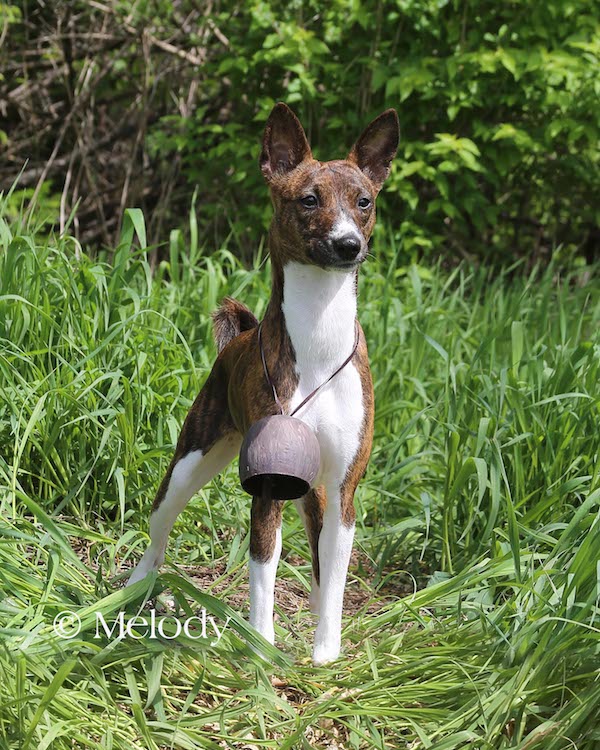
Your dog circles several times before settling down for a nap, or maybe he “digs” a bed each night before going to sleep. Meanwhile, the dog next door rolls in dead things, especially after a bath. And why does it take longer for a dog to search for the perfect place to perform her natural bathroom duty than it does for the dog to inform you of the urge, wait while you put the leash on, go for a walk, and return home again?
Some would say these dogs are being primitive, but strictly speaking, they are displaying primitive behaviors. A primitive breed is something else altogether.
Erroneously, some sites describe primitive breeds as dogs who still behave and react according to their ancestral nature, but a little homework suggests that there’s a lot more to it than that. Complicating matters is that “primitive dogs” have also been called by many different names that include aboriginal, ancient, pariah, indigenous, a land race, village dog, and edible, and this doesn’t even begin to include the cultural names given to these dogs.
Scientists researching these dogs have described primitive dog breeds as those that have maintained ancient genes, primitive appearance and retention of wild traits as “primitive dogs” (Beregovoy & Porter, 2007; Dwyer & Minnegal, 2016; Janice Koler-Matznick, 2002; Larson et al., 2012; Mehrkam & Wynne, 2014; Parker, 2004; vonHoldt et al., 2010).
The Primitive Dog Society fine-tunes the term more precisely: These are aboriginal dog breeds that “have always been linked to specific locations, regions, or countries. They have largely been undisturbed by crosses with dogs imported by travelers from Europe or other maritime colonial or merchant powers.” They haven’t interacted (and in some cases, even been exposed) to other dogs brought to their region by outsiders, and in many cases, they developed without the interference of man. According to this society, the only truly primitive dogs today are the New Guinea Singing Dog and Dingos because they’re the only dogs still living in a totally wild state.
Primitive breeds can be found virtually everywhere on earth, and because their evolution has often been associated with human migration and transhumance, there is a lot of diversity among them. Despite their variations, some cynologists think that all primitive dogs are descendants of two ancient strains: spitz type dogs and primitive type dogs, each of which had a different evolutionary path with roots in different regions.
Needless to say, this is a really big topic. As science updates and refines its tools, we’re learning more about the genetics behind these dogs, and our understanding of them is evolving. So, too, is our comprehension of what differences there are, if any, between pariah dogs (a term once used for any stray or feral dogs) and primitive dogs, some of which straddle the spectrum of wild to re-domesticated breeds.
We invite owners of primitive breeds to share pictures of their dogs, and to share with us why their breed is regarded as “primitive.” And what are those breeds? The list of them varies quite a bit among sources. The FIC’s Group 5 is named, “Primitive Type and Native Non-FCI, and includes the Canaan Dog, Thai Ridgeback Dog, Pharaoh Hound and Podengo Portugueso. The United Kennel Club’s “Sighthound & Pariah” group contains the sighthounds, of course, but also the Canaan Dog, Peruvian Inca Orchid Dog, Xolo, Carolina Dog,Chart Polski, New Guinea Singing Dog, Podenco Canario, Podengo Portugueso, Rhodesian Ridgeback, and Thai Ridgeback. Molly Sumridge’s site, CouchWolves, adds a host of additional breeds that includes the Naga Dog, Phu Quoc Dog, Yamthund, and more. PrimitiveDogs.com mentions the East African Dog, Bantu Dog, Zulu Dog, and Baganda Dog, and finally, we come full circle to the Primitive Dog Society which has a narrower list: Formosan Mountain Dog, Inuit Dog, Australian Dingo, New Guinea Singing Dog, Avuvi, Basenji, AfriCanis, Canaan Dog, Laika and the INDog (Indian Native Dog/Indian Pariah Dog).
Like we said, lists vary.
Image of “Hottie,” a Basenji, by Melody Falcone
melodyfalconephotoanddesign
https://www.facebook.com/melodyfalconephotoanddesign/

I like the PDS’s list. I don’t trust any list of prims that excludes the basenji!
Scout is a consummate scavenger, and the most exquisitely self-preservative domestic animal I’ve ever met.
Gasp, and he knows it, Kate, based on how he’s sitting in your photograph. He’s lovely!
I too agree, the Basenji needs to be on any primative list. Their independent nature and prey drive, to mention a few characteristics, still make them every bit a prized dog of the tribes people, by todays standards.
Lovely photo, Rhonda, thanks for writing and for sharing it!
In the primitive dog list what is an Avuvi? Also, Basenjis are almost unique in the group because, like wild canines, they come in season once each year triggered by the the days being shorter in fall, and that they do not bark. All this and recent DNA studies put basenjis at least 5,000 earlier than any other breed.
Jon, as far as we can tell, the Avuvi is a pariah-type village dog from Ghana, and based on at least one document we came across, there is a tie to the Basenji. You might find the read interesting: https://basenjiforums.com/assets/uploads/_imported_attachments/attachment_p_125852_0_avuvi-breed-emmanuelle-occansey-2003.pdf?v=1r6onqaqbkj
Raz is a Hong Kong Village Dog. People have said he looks like a Basenji although he is 30kg and certainly more of a guard/sight dog. His prey instinct is activated by squirrels although I don’t think he wants to harm anything. He is very gentle and loves to be shown affection.